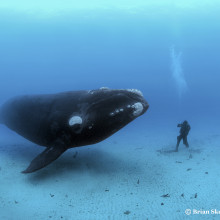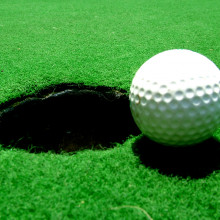Do you burn more calories when thinking?
This week: you asked the questions, we have the answers. Our expert panel take on queries like: why don't whales get the bends, does chloroform work like it does in the movies, and would a spinning spaceship simulate gravity? Plus, the week's science news, including the controversial sugar tax, how ExoMars 2016 hunts for life on the red planet and why NASA plan to set fire to a space station.
In this episode

What would happen if you covered a swimmer with a hydrophobic substance?
We put Luke's question to chemist Ben Pilgrim... Ben - Firstly I'll just recap what a hydrophobic substance is. Hydro obviously refers to water, phobic means dislike, so a hydrophobic substance is something that doesn't like water such as oil which won't mix with water and will sit on the surface of water. If we think about trying to move quickly through water, the main thing that stops that is drag. That's the problem moving through any fluid at speed; it's how quickly you make your way through the fluid and this is actually is a very interesting question. If you think back a few years ago you might have seen a number of swimmers wearing these full body suits which were subsequently banned.
Chris - They were called the sharkskin suit, weren't they?
Ben - And these suits did a number of things. One they sort of smoothed off the body to reduce little holes and things like that which might cause turbulence in the flow, but they also were coated in certain sorts of substances that trapped small amounts of air near to the surface and meant the water flowed over the swimmer much more quickly.
Chris - Did they work?
Ben - Did they work. Yes, they were reckoned to produce about a 2% increase in speed and a lot of world records were broken. However, this was then deemed that this was slightly unfair and so they were subsequently banned and limited in size. So to go back to the question, the main thing with going fast is drag. If you can have a hydrophobic substance that repels water, this can make a small increase, but the main thing is just to do with the shape at which the body is that moves through water.
Chris - And so, therefore, if you streamline your body but then you add something that repels water from your skin, it stops the water sticking to your skin so much, so you should go a bit faster.

Can you survive purely on a diet of avocados?
We put Tracey's question to nutrition expert Toni Steer...
Toni - That's an interesting one. Avocados have got things going for them so, for example, they are quite high in what we call a healthier fat, which is the monounsaturates, and the monounsaturated fats have been shown to modify your blood fat levels more favourably than things like saturated fat.
Chris - So when we have them, although you're getting a lot of 'fat' calories coming in, it's 'good for you fat' in the same way that olive oil is said to be 'good for you fat', this monounsaturated fat?
Toni - Yes. So overall you want to aim to reduce the amount of fat in your diet but, the fat that you do include, you want to modify; and avocados have got that kind of monounsaturated fat that is more desirable. One of the other things that avocados have got is that they've got some reasonable amounts of fibre, so around 3.5 grams of fibre per 100 grams, so that would an average avocado. They also contain potassium, like many fruits and vegetables.
Chris - So making them mildly radioactive?
Toni - Yes..
Chris - Aren't they Dave. Aren't bananas a little bit radioactive because they've got lots of potassium in them?
Dave - Yes it's the same isotopic form of potassium that they use in our hospitals and it's just floating around...
Chris - Potassium-40?
Toni - If you eat potassium then you're going to get irradiated slightly!
Chris - Because also Brazil nuts are radioactive, because of the soil they grow on and someone did tell me that you can equate a chest X-ray to the equivalent of a bag of brazil nuts. You get about the same dose of radiation equivalent to doing the two things. Anyway, I didn't mean to hijack your answer Toni, so do carry on and tell us about avocados. Is Tracey going to be okay?
Toni - The other thing that's quite interesting with them is there's some suggestion that adding avocados to other meals can enhance your carotenoid or vitamin A absorption. The evidence is kind of a little bit weak in that area. I think it's still really to be confirmed.
Chris - Is the rationale just because there's just loads of fat in the avocado?
Toni - Yes, so fat soluble...
Chris - And vitamin A's a fat soluble vitamin, so it helps?
Toni - Absolutely. What I would say though is on the downside, avocados are not really a great source of things like vitamin C, they're quite low in calcium, for example, not much iron so, actually, would you really want to survive just on a diet of avocados and, actually, you are going to be lacking.

Could a bee the size of a person fly?
Chris Basu, expert in animal biomechanics, answered Ultraviolet's question... Chris Basu - Yes, it's a great question. Just the imagery you know, imagining a bee the size of a person, it's great. But we do have this problem when we talk about scaling small animals up to larger sizes. If you imagine a cube, if you double the size of that cube, you actually increase it's weight by eight times and that's just a generalised law of scaling. When you scale up a bee to the size of a human, if you keep the shape and size of the wings the same, the wings actually become too small for the bee to get enough lift to get off the ground. The muscles are too small and also the material properties are just not good enough any more. The wings might become overly heavy, they might just break before anything actually happens; there's no way they'd be able to get off the ground. But there's fundamental problems as well; bees don't actually have lungs. They rely on the normal diffusion of air going from the outside into the inside of the body through a network of tubes and if you scale a bee up.
Chris - But aren't we the same? Don't we have a network of tubes that carry air from the outside into the inside of the body?
Chris Basu - We do, but we're active breathing, so we actively draw air into our chest and then we've got circulation which distributes the oxygen around our body but bees don't really have that so there's a size limitation that they can get to before they would just suffocate. So, if you imagine a bee the size of a human, it wouldn't last long at all, it would just fall over and die very quickly.

Are cells in your body really only 10 years old?
Chris Smith debunked this commonly repeated myth... Chris - Well it's definitely not true because actually your brain cells - you are born with those brain cells - they're formed as you're developing and they have to last you a lifetime and that's why we get neurodegenerative diseases when you lose brain cells. Also, there are other cells in things like your retina, which is part of your brain, those photoreceptors have to last you a lifetime. Muscle cells are only very slow at replacing themselves, for instance, cardiac muscle in your heart is only very, very slowly turning over, if at all, so that muscle has to last a lifetime. But, some cells, including fat cells, do last about twelve years and we know this because someone wrote to us at the Naked Scientists a little while ago and they said "can I carbon date my gran?" And this is someone from South Africa who said their grandma didn't know how old she was because she'd never been told the date of her birth. They were intrigued to find out how old she really was because they said she really is very old indeed - can we find out? And, in fact, there's a lady Kirsty Spalding at the Karolinska Institute in Sweden and she did some studies where they have done carbon dating of fat cells and you can use DNA for this because the DNA incorporates atmospheric carbon, which has got a carbon 14 radioactive signature in it and we know what the radioactive signature is doping over time. So we can use that as an index of age and they found that fat cells last about twelve years and then they sort of disappear and you replace them with new ones.

Is wine suitable for vegetarians?
We put Les' question to panelists Toni Steer and Chris Basu...
Toni - As far as I'm aware, I think it is suitable for vegetarians, although it does contain - I'm trying to think of the wine-making process.
Chris Basu - Wine isn't suitable for vegans if you're worried about animal by-products. A lot of alcohol, so beer and wine, in its manufacturing there's a process where you want to clear all the sediment from it and a lot of processes use fish bladder cells, I believe.
Chris - Can you count it towards on of your five a day though, more importantly Toni?
Toni - No absolutely not!
Chris - Even though it's made from all this healthy grape juice.
Toni - No, that's definitely not one of the five a day.
Chris - But red wine; there is an evidence base that red wine does have a nutritional benefit, doesn't it because if you've got the pips and the seeds there's lots of tannins and antioxidants in it?
Toni - There's this idea that actually, you've got fighter nutrients in red wine that are sort of beneficial in terms of looking at lowering blood pressure a little bit, or acting as antioxidants, reducing your risk of cardiovascular disease but I think that the totality of the evidence is a little bit cautious as to how much you should really have for that kind of beneficial effect. So I think drinking in moderation is still recommended.

Could a spinning space craft be the solution to the problems of micro gravity?
Physicist Dave Ansell had a spin at answering David Oehl's question... Dave - Microgravity is really bad for you because all sorts of things stop working. Your bones get very, very weak, your muscles get very, very weak.
Chris - What does it actually mean?
Dave - Microgravity, - if you're in space, if you're in orbit you're just free falling which means that everything is falling with you which means that you're effectively weightless because everything is falling at exactly the same speed as you are. So you can push off and float around - really quite fun but quite unhealthy. So the suggestion and it's actually been suggested for a long time (it might have been Arthur C. Clarke who came up with it)...
Chris - 2001: A Space Odyssey had a spinning space station.
Dave - A spinning space station because if you get a bucket and spin it round your head, then you need to apply a force to pull it in to keep it going in a circle.
Chris - But the evidence is if you fill it with water, the water doesn't come out.
Dave - Doesn't fall out. So basically you change the direction of gravity, and if you're in space the same thing happens and you'd create artificial gravity.
Chris - So if you had a big ring that was spinning, the person standing in one part of that ring in the same way as the fairground ride creates a sort of centrifugal effect, you feel thrown outwards and the ride pushes you back in to stop you flying off, the space station would, effectively, push up through the floor at you?
Dave - Yes. I think the reason why they haven't done it so far is that you either need to spin very, very fast or you need to be very, very big and that makes everything very heavy and basically, no-ones build a space station big enough or had people up there long enough to make it worthwhile doing it.
Chris - So if you had something very small that was turning very fast would that, nonetheless, whilst making some gravity make people feel extremely unwell whereas the rationale would be if you make it very big, the sense of rotation for a person would be smaller but they'd still, nonetheless, get the effect?
Dave - You probably would feel quite uncomfortable because, apart from anything else, everything would behave very, very strangely because you would get not just the centrifugal force, you get what's called the coriolis force so if you threw something into the middle of a spaceship it would actually spin round and end up going in a completely different direction from one you'd expect it to be. I don't know at what point it's actually worth doing this. Certainly there has been talk of doing it if you're sending someone to Mars over a few months if they're still in one piece to get there but certainly so far, no-one's tried.

How does chloroform cause unconsciousness?
We put Deeksha's question to resident chemist Ben Pilgrim...
Ben - The first thing to say is that the movies definitely have it wrong with regards to chloroform. Chloroform has been used as an anaesthetic for about 150 years and the kind of misconception that you have from watching movies is that by breathing a chloroform soaked rag you'll knock someone out within a second or so. This isn't the case, you need to be breathing it for several minutes in order to make someone pass out and they need to be breathing it constantly in order to keep them passed out. In fact, about 150 years ago, a famous medical journal, The Lancet, published a paper asking the criminal classes whether any one of them could divulge their supposed secret of being able to knock people out so quickly because it would be very, very useful for medicine. Needless to say, no-one has come forward to this date.
Chris - It was called a blow to the head probably, wasn't it, rather than chloroform! I think Queen Victoria was the first monarch to undergo a caesarean [section delivery]?
Ben - Yes for a couple of her last pregnancies. How does it work - this is something of debate and, indeed, in all anesthetics there is considerable debate about how they actually cause someone to pass out. Obviously they affect the nervous system. One idea is they affect the flux of potassium ions and this affects the body's response to nerves. Another idea is that the chloroform interferes with the cell membranes and slows down the passage of nerves which makes people less likely to feel pain. So there's a couple of ideas about how it might work. I should say, it was replaced because it was dangerous. Dangerous for a couple of reasons; one is actually you just breath too much of the gas in your lungs and this fills up your lungs and stops your lungs getting enough oxygen and so you just die from not having enough oxygen. But also, if you start fiddling around with the nervous system, then it can also cause people's hearts to fail because hearts rely on electrical impulses to work and if you mess around with that, you can die of a heart attack.
Chris - So don't do it is the bottom line, because people do abuse other kinds of solvents, like butane out of gas refills and glue - because there are solvents in there - all because they work the same way?
Ben - Yes, very dangerous to breathe in...

Why is it whales do not get the "bends"?
We put Guido's question to zoologist Chris Basu... Ben - Well, spoiler for the question - they actually can get the bends, we think. The bends is decompression sickness so, as you say, when scuba divers go down underwater they're using equipment which matches the pressure of the air to the pressure of the water around them. So, as you go down underwater, the water exerts massive pressure, it's pushing down on you. When you're breathing in air under pressure, air is about 78% nitrogen, under pressure that means more of the nitrogen gets pushed into your blood and when divers want to come back to the surface, they come up to the surface, the pressure around them decreases and all that excess nitrogen gas comes out of their blood. So imagine if you've got a....
Chris - So when you say comes out of their blood you mean as in while it's still in the blood?
Ben - Exactly, if you imagine like a can or a bottle of fizzy drink, if you open the cap really quickly, if you open it too quickly you see all these bubbles suddenly magically appearing, whereas if you do that slowly, you don't see that happening as much and that's exactly the same as what's happening in the blood of scuba divers when they're coming up. Now.
Chris - So when they come up slowly, why doesn't it happen?
Ben - Exactly. When they come up slowly, it allows the blood to form an equilibrium with the air much more slowly.
Chris - In the lungs?
Ben - Exactly. If you do it too quickly, then all that gas comes out the blood as bubbles and that causes problems.
Chris - So what you're saying is then, if they got lots of this dissolved nitrogen in their blood as a scuba diver, as they surface slowly because the blood's going past their lungs, it can slowly surrender the nitrogen to the lungs, the lungs inflate, they breath out the nitrogen harmlessly?
Ben - Exactly. So, in effect, the divers are actually off gassing. They're breathing out that nitrogen gas slowly and safely.
Chris - So what do the whales do then?
Ben - The whales have one major, major advantage - they're not breathing compressed air. When whales come to the surface, they take a breath. A lot of whales actually take a breath and they exhale before they go down. So they've got environmental sea air, if you like, and as they go down that air actually gets compressed but it's not the same as a scuba diver breathing in massive lungs full of.
Chris - Compressed air?
Ben - Pressurised air, exactly. But they still have a little bit of air in their lungs. They can't empty their lungs and their trachea, their windpipe completely so they've got this little bit of air. It means they can actually get some pressurised nitrogen seeping into their blood but it's in really, really, small amounts and they've got a couple of things that helps them. They've got lots of special fat in their body and that helps to actually mop up the excess nitrogen and they can also store the air in funny places. Their trachea (windpipe) is actually distensible so when they go down their lungs get compressed but a lot of that air gets forced up into their trachea and it doesn't enter the blood at all. It's really amazing these beach whales, they can actually dive down to three kilometers, which is 300 times the atmospheric pressure of the air.
Chris - Incredible, isn't it? So you mentioned at the beginning you said well they actually can get this so why do they occasionally get the bends then?
Ben - The other thing that they do, they're very sensible. Like scuba divers they also don't come straight up to the surface, they come nice and slowly but when something disturbs that behaviour, they might actually be prone to getting the bends. A few years ago, people were noting certain associations between sonar activity of military vessels and whale strandings and they actually found in these stranded whales the telltale signs that they had the bends, they had decompression sickness. When people look at bones of whales, bones actually have little telltale signs as well when the animal's had chronic exposure to decompression sickness, they have these little spots on the bone. So we can actually see that whales do from time to time tend to suffer from it but it's something that they have learned to live with.

19:51 - Sugar tax planned by parliament
Sugar tax planned by parliament
with Toni Steer, MRC Human Nutrition Research Unit
This week, UK politicians unveiled plans for a tax on sugary drinks, aiming to reduce  the level of obesity in children. Nutritionist Toni Steer explained how it is supposed to work, and why it is controversial, to Chris Smith...
the level of obesity in children. Nutritionist Toni Steer explained how it is supposed to work, and why it is controversial, to Chris Smith...
Toni - Well what the government want to do, they want to introduce a levy onto soft drinks. So what they want to do is introduce this levy for about 2018 and it's to do with the amount of sugar per litre or per 100mls that in soft drinks. So they want to tax the industry which means that there'll be; I think it's around 5 grams per 100msl at a lower level and I think 8 grams per 100mls at a higher level. It's sort of in that region. Now this is the idea that they want to try and tackle our consumption of soft drinks because we've got a lot of evidence to show now that actually, sugar-rich drinks, not only are bad for your teeth and dental health but, actually, what they tend to is they undermine your appetite control. So the liquid calories that you have in soft drinks don't seem to register very well that you've consumed them and if you consume excess calories in liquid calories, you consume more calories you gain weight.
Chris - We did a demo on this programme actually, where Giles Yeo who works on how the brain decodes how much energy you're taking into your body, gave me a bunch of apples and said you're going to eat the number of calories that had gone into what I'm going to drink and we're going to see who gets there first. He drank the equivalent of the apples as juice and I had to eat them. He finished off half a pint of apple juice and that was the equivalent of six apples and I'd managed two apples in the time it took us to do that. I mean that's the point he's making, it's very easy to put a lot of calories in very quickly.
Toni - It's really easy to consume excess calories in that liquid form so looking at our concern around obesity and overweight, this is one of the ways that we want to try and create an environment that perhaps makes soft drinks less desirable.
Chris - Haven't people always eaten sugar Toni? This isn't a new thing. We've had people eating honey and so on for thousands of years.
Toni - We have but I think it's much more prevalent. If you look at the number of processed foods we have; it you look at the availability of soft drinks, sugar rich drinks, we've got them readily available in supermarkets open 24 hours a day, 7 days a week. It's really easy to get those kind of high sugar type food and drinks. In terms of the sugar tax, it's actually really difficult to know when they roll it out what the impact will be. One of the things that might happen is that manufacturers may be encouraged to reformulate their soft drinks which would then get them down to a lower tax levy.
Chris - One politician said all it will do is encourage some people to switch to the cheaper, nastier brands that are cheaper to start with but with just as much sugar but, even with the levy on, they become the price of the more expensive brand they prefered before.
Toni - It's really difficult to know how it's going to roll out because the other way is that actually what might happen is that the industry may absorb that tax increase and what you'll see is that there may even be an increase on all drinks across that product range.
Chris - They'll say we know it bad but we're just going to make you live with it because you like it.
Toni - If all the soft drink prices go up that may result in some people perhaps not choosing them..
Chris - What about if we look at other things. Because we've had the salt lobby - have tried to get down the amount of salt in food. We've also had fairly punitive taxes in some countries applied to things like cigarettes and alcohol. Is there any evidence these sorts of carrot and stick maneuvers work?
Toni - I think there was some evidence. I know that they cite stories a lot from Mexico where they introduced this sugar tax, and I think that there was some evidence that in some groups of the population, you did get people not buying them and perhaps choosing the diet versions and I think for it to work, what the public need to see is a really clear price differentiation between the high sugar drinks and the no sugar drinks and once you see that it begins to make the choice a lot more obvious. So how this will roll out in reality we don't really know but I think once of the important things is good surveillance so that we can monitor what the kind of consumption patterns are over the next few years and that's one of the things that we do in our unit actually, we do one of the nutrition surveys. So it's difficult to know but what we have to remember is that this is just one part of tackling the obesity epidemic. It's not the solution but if we have a whole range of things, eventually it helps create that better environment that helps encourage people to make better choices because it's really difficult for individuals. We're living in an environment that makes it so easy to choose and consume these foods.
Chris - It sadly does. Chris?
Chris Basu - This might open a can of worms. Are diet drinks any more safe than normal sugary drinks?
Toni - I think what you might be citing or thinking about is there have been some studies, I think there was a particularly notable one that was carried out somewhere in Italy in rats looking at artificial sweeteners and whether actually, excessive amount of artificial sweeteners may cause or increase the risk of cancer. I think what they've found is they did see this increase with the artificial sweeteners in this cancer risk but you have to remember that the rats were given these doses of carcinogens which put them at risk of developing cancer anyway. And I can't quite remember but I think it was something like the rats were drinking an equivalent of about 300 cans of coke a day. It wasn't quite the realistic way that you would replicate it in a human study. I think there was some evidence but not enough

25:50 - NASA plan to set fire to space station
NASA plan to set fire to space station
with Dave Ansell, Cambridge Science Centre
This week, NASA unveiled plans to set fire to an (unmanned) space station, because  we have relatively poor understanding of how fires behave in space. Dave Ansell gave Chris Smith further detail on the story...
we have relatively poor understanding of how fires behave in space. Dave Ansell gave Chris Smith further detail on the story...
Dave - Well the problem is that fire on earth we understand very well. It works because air heats up, expands and then it floats upwards and that brings more air in underneath, and the flames go upwards and the air comes into the bottom and it burns away happily and we understand that really, really well. In space basically, it's microgravity which means that everything's falling, so heavy things don't fall faster than light things which means light things don't float up above heavy things. So fire in space behaves completely differently. It's entirely dependent on the rate at which oxygen can diffuse into the fuel and that also means it gets cooled down less quickly because the air rushing past it also cools it down and, to be honest, they just don't know what works and they don't know how, especially, a big fire will happen because, luckily, there's never been one on a spaceship.
Chris - So just in summary then. A candle on earth you light that, this will produce a chemical reaction that produces some heat which causes the hot gases, which are the combustion products (a lot of carbon dioxide), they're going to rise up out of the way pulling in nice fresh air with lots of oxygen, and that's because the candle "knows" where up and down is?
Dave - Yes.
Chris - Because of earth's gravity. If you're in freefall in space, there's no net up and down so the gas blows up just like a bubble, the exhaust gases and this would choke off the flame, one would think.
Dave - Because it's not getting cooled down as quickly it still can burn. It burns much more slowly and it's much less predictable because there's not up no down, you don't know what direction it's going to travel.
Chris - So what are NASA going to do?
Dave - So luckily, the cargo ships which they're sending up are one of the kind of ships which have an oxygen atmosphere because most spaceships don't have an oxygen atmosphere. There's no people there: who cares? They go up to the space station, they unload a load of kit and then they just go down and get burned up in the atmosphere. So someone thought ha ha, we can use this. Let's put a big box inside with some stuff to burn on the way back down. In a couple of months time on its way back down they're going to set fire to it and see what happens. They don't think it's actually going to cause the spaceship to be damaged.
Chris - How are they going to monitor it? Have they got cameras in there are something?
Dave - They've got cameras in there and lots of sensors (gas sensors), temperature sensors, as much as they can possibly get into a small box. It's going to be a 4ft long by 2ft high box - it's actually quite big for sending out into space and hopefully that means that the next space station that they build, they'll understand fire a lot better, which means they can build it to cope with fires a lot better because at some point it's going to happen and it could be very, very nasty.
Chris - Sure. Have they got various over-engineered solutions in the present space station just in case there were a fire and that's obviously adding a lot of weight, and if you could save a lot of weight because you engineer things slightly differently because you don't need it, it would obviously make space travel more predictable and viable ?
Dave - Definitely, when you've got an uncertainty, engineers will increase the margins and make everything heavier and more expensive and more high tech, and if we can get away without it, or we might find there's some great big holes in the defences and you could burn out a space station and we don't know that it's going to happen.
Chris Basu - How do people plan to put fires out on space anyway because you can't use sprinklers because the water would just float away?
Chris - The water would just be hanging on with the fire extinguisher wouldn't you?
Dave - I think you can, I guess, for small fires some kind of fire extinguisher will work. Astronauts are trained to stand on things and as long as they're expecting it, they can deal with it. With extreme fires you can pump halon gas into the chamber which also will kill any people in there so you've got to make sure you evacuate first. I guess, if it's really, really extreme you can just vent all the air out of it and there's no oxygen there to burn.

Can we recover energy from plastics?
We put Helen's question to Cambridge University's Ben Pilgrim... [TRANSCRIPT TO FOLLOW]

Do brains burn more calories when thinking?
We put this brain teaser to nutritionist Toni Steer...
Toni - So, it’s absolutely right, the brain does require round about 20% of your daily energy intake. The brain relies on glucose; it has to have glucose for energy so unlike other parts of your body, for example, other organs or muscles which can use fatty acids, the brain has to use glucose and it needs around about 120 grams of glucose a day. Most of the evidence indicates that, actually, you don’t see a significant increase in energy consumption with people doing mental tasks. There have been some techniques where they can scan metabolic activity in different regions of the brain and it’s looking at how the glucose moves and is utilised in different regions, and there is some suggestion that when you’re given a specific task you see more metabolic activity and glucose utilisation in different regions of the brain. But the overall impact of total energy requirement is very minimal and so the idea that if you’re going for a day’s lecture at university you need several chocolate bars, I’m afraid is not true.
Chris - Damn!
Toni - It’s not going to happen. Maybe the tiredness could be many other factors and, actually, one of them is good hydration. So tiredness and not being able to concentrate is often about making sure you’re well hydrated.

32:59 - Dogs at risk from tick-borne disease
Dogs at risk from tick-borne disease
with Chris Basu, Royal Veterinarian College
Dog walkers are being told to avoid certain areas, as several cases of a disease  caused by a tick-borne parasite have cropped up in the past few weeks. Chris Basu explained what has been causing the concern...
caused by a tick-borne parasite have cropped up in the past few weeks. Chris Basu explained what has been causing the concern...
Chris Basu - In the past few weeks we've diagnosed a few cases of something called Babesia in some dogs in Essex. Babesia is a blood parasite that is transmitted by ticks; these little eight legged creatures that suck blood. Babesia is quite an exotic disease which makes it sound nicer than what it is; meaning it is a disease that's found in warmer climates. It's most often found in European countries but we're actually starting to find it more and more in this country. Part of the reason for that is we have lots of import and export of pet dogs. We have lots of dogs coming in from countries in Europe or pet owners in this country taking their dogs on holiday, bringing them back. So we're seeing lots of these diseases coming in that route but what's significant is we're now seeing these diseases in dogs that have never traveled abroad and that's something we've found in the past few weeks in these dogs.
Chris - What happens when a dog gets this.
Chris Basu - It's a nasty parasite. It's a blood parasite, meaning when it's transmitted by a tick, the little parasite bury themselves into red blood cells and they reproduce. When they do this the red blood cells actually break down meaning the dogs can get very suddenly very ill from anaemia and the symptoms might vary from just a bit of weakness, a bit of tiredness, but sometimes the symptoms can be very severe indeed and the dogs can very quickly die. It's a very serious disease indeed.
Chris - How do you treat it? Can you treat it?
Chris Basu - It's a really tricky thing to treat. There are ways that we can treat it but the effectiveness of the treatment isn't fantastic and even if we think the dogs are cured, there's absolutely no guarantee they're cured and can relapse in future. So prevention is definitely better than trying to mop it up afterwards.
Chris - Toni...
Toni - I just wanted to ask is there any evidence it's transferable to another animal?
Chris - And humans?
Chris Basu - The parasite itself (Babesia canis) is quite dog specific. There are different Babesia species that people can get but they're completely different so no-one's going to get sick from their dogs which have this disease. Because it's a blood parasite, there can be transmission between dogs but it usually has to be blood to blood so dogs that are fighting, for example, are more at risk but the more normal route is picking up from an infected tick.
Chris - Are those ticks distributed right across the UK or are there hot spots?
Chris Basu - There are hot spots but if you look at the distribution or the places where people have identified these ticks then yes, they're actually pretty widespread across the UK but there are concentrations in pockets.
Chris - Dave...
Dave - So why weren't we getting it in this country before? Is it a climate change thing with different ticks.
Chris Basu - Yes, it potentially is a climate change thing. The parasites and the ticks themselves, they tend to be found in more warmer climates. As you've noticed, we've had some very mild winters over the past few years and it's possible then that these diseases aren't dying off over winter, so it's possible they're actually starting to build up. Then, controversially, a few years ago, there was a relaxation in the pet import and export rules. Prior to (I think) 2012/2013 you had to actually treat your animal for ticks before it came into this country and they've relaxed that now so you don't have to do that, so it might be linked to that as well, so that's a relatively controversial decision.

Would dimples on planes make them more aerodynamic?
Dave Ansel had a go at answering Kevin's question... Dave - That's a really, really interesting question. So golf balls have dimples because if you had a perfectly smooth golf ball and you hit it really hard, what happens is you get really big swirls of air coming off the back of it, the air gets round the first half of the ball it detaches and you get these big swirls out the back of it and that causes a lot of drag. Now if you have the dimples and what it does is it creates small swirls, which actually tend to mean the air detaches from the ball later, and that means that you get less drag overall so the ball goes faster and further. Now, planes normally are in a very different regime. They've carefully designed their wings so you don't get very much turbulence off the top and, in fact, when you do get this kind of turbulence it's the detachment of the air flow (it's called a stall), that's normally something which you want to try and avoid and so mostly when you're flying dimples would just give you a bit more drag and make it worse. However, if you're about to stall, having dimples can be useful and, in fact, planes do have things like dimples (called vortex generators) and these are little fins attached to the front of the wing and they can delay the stall a bit so that the planes can fly slower, and land slower, and land on shorter airfields, and things like this. But most of the time you don't need them and all planes have them.

37:59 - ExoMars 2016 launches
ExoMars 2016 launches
with Ben Pilgrim, Cambridge University
The ExoMars 2016 probe launched successfully last week. This mission aims to seek out methane, which could be a crucial clue to whether there is life on the red planet, as Ben Pilgrim explained...
Ben - The European Space Agency launched the ExoMars probe recently and this is the latest in a series of probes to go to Mars and it's going to look for methane. It's going to look for methane in a search for life on Mars.
This has been one of the biggest scientific question for hundreds of years actually, and if life on Mars were discovered it would certainly be one of the biggest scientific discoveries ever. Now, why methane is important is, if you think about Earth, most methane on Earth is produced by living things. A process called methanogenesis; this is where, if you imagine a swamp or somewhere like this or a rubbish tip, there's not much oxygen, we get bacteria breaking down carbon-based products and they produce methane and they use this anaerobic respiration process to produce their energy.
Now, methane in the atmosphere doesn't last very long; the radiation coming from the Sun in the Earth's atmosphere can generate single oxygen, then we get these hydro radicals and this breaks down methane. So atmospheric methane doesn't last very long so, if it's present, it had to have been generated reasonably recently and a couple of probes that have been to Mars in the last ten years or so, detected the presence of small amounts of methane. So there is methane in the martian atmosphere and then the question is, well how did it get there.
There are other processes that can produce methane in the atmosphere other than living things. It can come from volcanic activity or it can also come from the action of, again, strong sun radiation on organic compounds that might have got there on meteorites or something like that.
So, the presence of methane doesn't suggest life in itself, but this probe has gone to look at it in more detail. It has instruments on it that will be able to detect, perhaps, what other gases are present to give us an idea on the source of the methane and also to look at, more specifically, the isotope composition in methane which will, again, help to track down its origin.

Do unripe pairs contain the same about energy as ripe pears?
We put Denis' question to nutritionist Toni Steer... Toni - I think the short answer to Dennis' question is no. The human body is very efficient at extracting calories from food. There is some evidence to show, and I've looked at this actually with ripe and unripe bananas, is that with the riper banana you get a slightly quicker rise in blood glucose.
Chris - Did you eat an unripe banana?
Toni - This isn't me. This is a paper so.
Chris - Oh, so you make some other poor person eat it. That's disgusting!
Toni - It wasn't that bad. So with the unripe banana you see a slightly slower rise in blood glucose, so you could probably apply that same kind of theory as well to the pear in question but, nevertheless, the digestion of the starches and the sugars is very efficient. So we have the amylase in the mouth that breaks down the starch. You've got the stomach that mixes the food and breaks it down and actually, by the time you get to the small intestine, around about 50% of your starch is already started to be broken down. Then the breakdown really into the monosaccharides or the simple sugars from the fruit occurs then in the small intestine so, by the time time it gets to the small intestine it's very efficiently broken down and very efficiently absorbed. So I think the answer is; don't worry about the ripeness too much - you'll get the calories from it.

Why are some animals asymmetrical?
We put Gary's questions to animal expert Chris Basu... Chris Basu - It's a good question. Symmetry in an evolutionary sense is really, really old so most of the animal organisms around us are symmetrical, we can see that in us. We're bilaterally symmetrical, so I have two hand and two legs but we see some animals deviate from this. The animals we tend to think of as asymmetrical - the Fiddler Crab, for example - that's one really famous example. It is actually a symmetrical creature. A lot of these so-called asymmetrical animals actually start off being symmetrical at some stage. That might be when they're either a baby or it might be before they were babies when they're an embryo or a larval stage if they're that kind of creature. The Fiddler Crabs when they're larvae actually have two identically sized claws and it's as they grow, it's usually one of them just becomes much, much, much larger.
Chris - Are they righthanded and lefthanded?
Chris Basu - I was just thinking that in my head. I believe it's the left claw but there's a 50/50 chance I could be wrong.
Chris - Or right on the other hand. That's about 100% chance that most of the people listening are not going to know. But why do they have that asymmetry - do we know?
Chris Basu - It's a difficult question; why did this evolve. All we can do is we can look at the function so we can see what they actually do and, as far as we can see, there's two things that the Fiddler Crabs do with their large claw. One is they wave it around and they try to attract a mate, so females generally like to select male Fiddler Crabs with large claws. But we've also, potentially, identified another function which is the large claw actually helps them to dissipate heat so if they don't have this large claw they're more prone to heatstroke.
Chris - As Gary says; why not just have them symmetrical because you could easily predict your heat loss if you had two the same?
Chris Basu - Yes, that's true. It's difficult to say at what point that's happened but it might be something to do with the fact that growing a large claw is actually quite costly; it's expensive. You have to devote lots and lots of resources so having one might be more economical than having two.

What would happen if you switched on a laser pointer in space?
We ask Dave Ansel for the answer to Allan's question... Dave - You certainly can. In fact, it's absolutely tiny, but you will get pushed backwards very, very, slowly. In fact, they're planning to use the same principle to sail around the solar system. So, if you build yourself a very, very, very large mirror and then the sunlight shines on it, then the light is coming towards it in one direction, it's reflected back again and that means it's changed it's direction and your mirror will get pushed away. The force is a tiny micro-newtons (I mean mili-newtons), but because you don't need to carry fuel to do that you can keep your rocket engine going continuously as you fly round the solar system. It means you can actually travel round the solar system, especially if you're going a long way, far quicker than you could.
Chris - Because over time, it will build up, and build up, and build up with no losses because there's almost nothing to hit you and slow you down again.
Dave - It's been suggested it's one of the ways you could get to another solar system would be to have one of these solar sails and a very, very, very large laser. Point at the solar sail and then sail on it all the way out to another star.

Is flossing good for your general health?
Chris Smith answered Chani's question...
Chris - The answer is yes and scientists at the University of Otago in New Zealand have shown that if you don't floss your teeth, actually your risk of having heart disease and stroke is much, much higher because it increases inflammation in your blood vessels and encourages them to become furred up.

How much ice-cream would I need to eat to get my daily source of dairy?
We put Margaret's question to nutrition expert Toni Steer, after taking guesses from the panel... Chris - Ben what do you think. How much ice cream do you think she has to eat to supply her daily nutritional intake from ice cream alone?
Ben - Um. a kilo.
Chris - He's going a kilo, okay. Is that based on any kind of personal experience or have you just plucked that out the freezer?
Ben - Maybe one or two depressed evenings. No it's just a rough guess.
Chris - Chris?
Chris Basu - Well it depends on the ice cream.
Chris - Well yes, if it's got chocolate chip in there it's a bit more calories in there...
Chris Basu - Exactly. If you get really dense like Cornish clotted cream. I don't know. I need to know more information.
Chris - Okay. Chris is unhappy with the data supplied.
Dave - what do you think? You don't like dairy things do you so.
Toni - what do you think?
Toni - I think that's going to be a little bit tricky, so I think I read it that she was talking about dairy nutrition in the context of calcium. So just to start with that, for example, the average calcium content of a vanilla dairy ice cream is around about 100 mg of calcium per 100 grams. An adult requirement is 7-800 mg of calcium per day so, even to achieve that, you'd need 7-800 grams of ice cream.
Chris - Ah, Ben wasn't far out. He was quite close. He was pretty good, yes.
Toni - Not bad. But the disadvantages with doing something like that I can see immediately is thing like the sugar content. So, looking at an average vanilla ice cream, the sugar content in 7-800 mls of that ice cream is something like 150-160 grams of sugar. Now considering the recommendations for added sugars are no more than 30 grams a day, that takes you way over so it's probably a bad move in that respect but also I think just having ice cream in your diet means you're going to lack things like fibre, like iron and I think it's going to set you up for some trouble.
Dave - 7-800 mls seems an awful lot because you expect ice cream to be concentrated milk. Is that because the calciums not in the cream part of the milk?
Toni - So the calcium, yes, it's in the water soluble phase and that's quite interesting really because people often say to me look, if I switch from full fat milk to semi-skimmed, am I going to lose out on my calcium? And actually the answer is no. What happens is once you remove the fat you get slightly more calcium in semi-skimmed milk. Not a lot, but slightly more, and then again for skimmed milk as well.










Comments
Add a comment